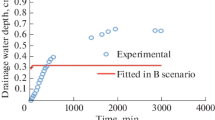Abstract
Bio-drainage can be considered as an important part of sustainable irrigation water management. Bio-drainage has potential for managing shallow water conditions in arid and semiarid areas especially when traditional subsurface drains are not available. Bio-drainage theory does not go back too far. The relationship between soil characteristics, water management regimes, and climatic conditions is not yet well defined. This study attempted to use a mathematical model (SAHYSMOD) to evaluate factors affecting design and operation of a bio-drainage system and study its sensitivity to different variables. The study showed that the major constraint of bio-drainage is salt accumulation in tree plantation strips in arid and semiarid regions. Maximum soil water salinity which can be controlled by bio-drainage is around 3 dS m−1 in rather medium run and sustainability may only be achieved where a salt removal mechanism is considered. The study also showed that the effectiveness of the system is higher where the neighboring strips are narrower. It also showed that bio-drainage is very sensitive to the amount of applied water. While the barrier depth does not have an important effect on water table draw down, it does have a great influence on lowering the salinization rate of tree plantation strips. The application of bio-drainage could be economically controversial since in humid areas water is sufficient for agricultural crops, allocating parts of the expensive land to mostly non-fruit trees may not be feasible, while in arid and semiarid regions there is usually enough cheap land to grow trees.








Similar content being viewed by others
References
Akram S (2006) Sensitivity analysis of bio-drainage systems on salinity using SAHYSMOD model. Proceedings of the Fourth Technical Workshop on Drainage, IRNCID (in Farsi)
Boonstra J, de Ridder NA (1990) Numerical modeling of groundwater basins, 2nd edn. ILRI Publication 29, Wageningen, p 226
Chhabra R, Thakur NP (1998) Biodrainage using tree to control water logging and secondary salinization in canal irrigated areas. Proceeding of the National Conference on Salinity Management in Agriculture, Central Soil Salinity Research Institute, Karnal, India
Denecke HW (2001) Concept note on biodrainage and bio-disposal systems. Available at http://www.fao.org/iptrid/drainage/bio_drainage/concept-note-bio-drainage.htm
Heuperman AF (2000) Biodrainage: an Australian overview and two Victorian case studies. Proceedings of the 8th ICID International Drainage Workshop, New Delhi, India
Heuperman AF (2003) Bio-drainage; a situation analysis. Institute of Sustainable Irrigated Agriculture (ISIA) at Tatura, Australia, for the International Programme for Technology and Research in Irrigation and Drainage (IPTRID)
Heuperman AF, Kapoor AS, Denecke HW (2002) Biodrainage- Principles, Experiences and Applications. FAO-IPTRID Knowledge Synthesis Report No. 6, ISSN 1607–6613
Kapoor AS, Denecke HW (2001) Biodrainage and biodisposal: the Rajasthan experience. In GRID, IPTRID’s network magazine no. 17
Liaghat AM Biodrainage (2004) Proceedings of the Third Technical Workshop on Drainage, IRNCID (in Farsi)
Oosterbaan RJ (2002) SALTMOD, Description of principle, user manual, and examples of application. Available at http://www.waterlog.info/
SAHYSMOD Working Group of ILRI, SAHYSMOD, SPATIAL-AGRO-HYDRO-SALINITY Model, version 1.5 March 2003, Description of Principles, User Manual, and Case Studies
SAHYSMOD Working Group of ILRI, SAHYSMOD, SPATIAL-AGRO-HYDRO-SALINITY Model, version 1.7 March 2005, Description of Principles, User Manual, and Case Studies
Shirahatti SS et al (2001) Assessment of net groundwater recharge in irrigation command areas using inverse modeling approach. American Society of Agricultural and Biological Engineers. Available at http://www.asabe.net/
Singh R (2005) Water productivity analysis from field to regional scale. Doctoral Thesis, Wageningen University, p 146
Singh M et al (2002) Application of SALTMOD in Coastal Clay Soil in India. Irrig Drain Syst 16(3):213–231 doi:10.1023/A:1021261707322
Smedema LK (1997) Biological drainage: myth or opportunity? GRID, magazine of the IPTRID network, Issue 11, p 3
Acknowledgement
The authors would like to sincerely express their gratitude to R. J. Oosterbaan, from International Land Reclamation Institute (ILRI), Wageningen, The Netherlands for his generous assistance in modeling.
Author information
Authors and Affiliations
Corresponding author
Rights and permissions
About this article
Cite this article
Akram, S., Kashkouli, H.A. & Pazira, E. Sensitive variables controlling salinity and water table in a bio-drainage system. Irrig Drainage Syst 22, 271–285 (2008). https://doi.org/10.1007/s10795-008-9056-4
Received:
Accepted:
Published:
Issue Date:
DOI: https://doi.org/10.1007/s10795-008-9056-4




